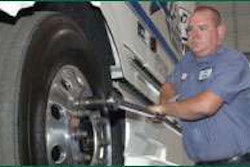Optimizing Oils

Oil drain intervals took a beating when exhaust gas recirculation (EGR) systems were first introduced to heavy-duty trucks less than a decade ago. Many 2003 engines were required to head back to the shop every 18,000 miles for a fresh supply of the protective fluid, recalls Dan Arcy, the OEM technical manager with Shell Global Solutions.
But the trucking industry has steadily regained some of the lost ground. Today’s oil drain intervals are likely to be closer to 25,000 miles thanks to advances in engines and lubricants alike – and that is only the beginning for those who are willing to push the limits of the chemistry.
“Some are able to extend drains 50 percent, which means you can use half the oil, filters and labor,” notes James Gambill, Chevron Lubricants’ direct marketing specialist, referring to successes at extending drain intervals beyond the standard limits set by engine manufacturers. Shops simply need to help interested fleets understand and manage the related risks before these longer drain intervals can become a reality.
“This is not for everybody,” he stresses. “A short-haul fleet, for example, may have less to gain than a long-haul fleet…And if you are extending drains, what happens when you can’t get your equipment back? You have to have good maintenance and scheduling practices.”
The added costs do not end with potential mechanical issues. “There’s a fuel economy penalty that can develop where you reach a point of diminishing returns,” notes Vic Kersey, Valvoline’s technical director – commercial products. “As an oil ages, it becomes more viscous.”
But the numbers can often make financial sense for equipment owners, particularly once downtime is factored into the equation.
Arcy suggests that any discussions about optimizing oil drain intervals should begin by analyzing existing engine models, vehicle applications and the number of miles traveled every year. “I’ve seen some fleets that, just because of the way their fleets run, they can vary from 5,000 miles from one [vehicle’s] drain interval to the next,” he notes. When dealing with different engine nameplates, these fleets will usually tend to set schedules based on the “lowest common denominator.”
The schedules can even be influenced by maintenance intervals that have nothing to do with the engine itself, as truck owners try to align as many service procedures as possible. “There are fleets out there that pull their trucks in on a periodic basis such as 90 days, no matter what,” Arcy explains, noting how these companies will try to capture minor repairs at home before needing to contend with the higher costs of breakdowns on the road.
When fleets do adopt extended drain intervals, they always need to embrace a thorough oil analysis program to ensure that the engines remain protected.
The analysis itself will monitor a long list of factors, including viscosity, wear metals, additive metals, contaminants, total base number, oxidation, fuel dilution and soot. “Another often overlooked key is to be sure and note the equipment number of the truck, the oil and miles or hours of service. This will allow very helpful trending information which will help you examine the effectiveness of the program,” Gambill adds.
The results of these laboratory tests will have different meanings depending on the equipment being used. Some engine manufacturers will set the “condemning limits” for the oil’s total base number (TBN) at 2.5, while others will set the threshold at 3.0. The differences are not limited to this result, either. Iron limits set at 200 ppm for one model of engine can drop to 150 ppm for another model; one manufacturer might emphasize fuel dilution more than the next. There can even be differences between a manufacturer’s different engine families.
The quality of the analysis program itself will be important as well. “Bad data is worse than no data,” Kersey says.
The observations are not limited to the confines of a laboratory, either. Oil levels also need to be carefully maintained throughout the process, Gambill notes. “Don’t take that for granted. If the oil is low, the oil does not have time to get rid of the heat collected from the engine. Also, an oil level which is too high can cause improper lubrication in some engines.”
A successful bid to extend drain intervals will also depend on an engine oil that is up to the task, and that will involve posing some important questions to suppliers.
“The customer really needs to seek out a quality branded product. I mean ‘Top Tier.’ You don’t go to a fleet-grade engine oil,” Kersey stresses. The fleet grade may meet the qualifications identified on the label, such as the standards for CJ4, but its capabilities end at those limits. An oil destined for an extended drain interval should exceed the requirements for anti-oxidant detergents and dispersants alike.
“The shop should also ask what type of heavy-duty OEM approvals are included as part of the oil formulation to ensure they can supply products that meet appropriate heavy-duty engine platform requirements they may service – Chevron’s Delo 400 LE with ISOSYN Technology meets many OEM approvals including Volvo, Mercedes-Benz, Cummins and Caterpillar to name a few,” says Gambill.
“Ask questions about what kind of testing they have done to support extended drains,” Arcy adds. Even if an oil has a higher TBN or alkaline reserve, it might deplete at a faster rate. “You can’t necessarily say specifically that a 10 TBN is necessarily worse than an 11 TBN…they could at the end of the interval have the same amount of alkaline reserve.”
The decision to establish an extended drain interval for engine oil will need to consider the life of other fluids as well. Any selected grease, coolants and gear oils, for example, will need to last until the equipment returns to the shop. “If an operator does not pay attention to these ancillary coolant and lubrication areas, the truck can be sidelined just as fast as an engine failure,” Gambill says.
But even once a decision is made to extend the drains, Arcy warns against pushing the oil to extreme limits. “Let’s say 30,000 miles is where you can go and it’s at the end life of the oil,” he says. “I’m going to say back it off by 20 percent just to give yourself some breathing room, because operating conditions can change.”
It is also a matter of being honest about operating realities.
“If you target it with 25,000 miles for your standard oil drain interval, how good are you at hitting that 25,000-mile interval?” Kersey notes. Most of the time, the trucks may be serviced within 2,000 miles of that limit. But how many are already being pushed to 30,000, 35,000 or even 40,000 miles? “Sometimes I’ve seen them miss an oil drain completely,” Kersey says. “Those factors are all weighed in [to the scheduling].” n










